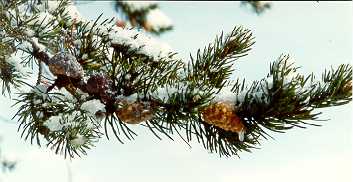Fire regime and serotiny in Jack pine
 Jack Pine is a fire adapted species. Jack pine trees can bear serotinous cones (cones
remaining closed until the occurrence of high temperatures such as created by a fire) and
non-serotinous cones (that will open when mature, even in the absence of high
temperatures). The occurrence of lethal fires tends to favor serotinous-type jack pine
trees to the detriment of non-serotinous trees (fig. 1; Gauthier et al., 1996).
Serotinous jack pine trees killed by a fire can disperse seeds, thus ensuring stand
regeneration, while previously dispersed seeds from non-serotinous trees will be destroyed
by the same fire. Jack Pine is a fire adapted species. Jack pine trees can bear serotinous cones (cones
remaining closed until the occurrence of high temperatures such as created by a fire) and
non-serotinous cones (that will open when mature, even in the absence of high
temperatures). The occurrence of lethal fires tends to favor serotinous-type jack pine
trees to the detriment of non-serotinous trees (fig. 1; Gauthier et al., 1996).
Serotinous jack pine trees killed by a fire can disperse seeds, thus ensuring stand
regeneration, while previously dispersed seeds from non-serotinous trees will be destroyed
by the same fire.
In contrast, on islands where non-lethal fires have been
recorded, non-serotinous and " mixed " trees are more abundant while
serotinous trees are less abundant (fig. 1). The occurrence of non-lethal fires, while
providing an advantage to non-serotinous trees that can seed in after low intensity fires
and, in the absence of fire, is also thought to be responsible for the uneven-age
structure of jack pine populations on islands (fig. 2; Gauthier et al., 1993).
On the mainland, even-aged populations are observed, where most trees are established
within 10 years after the occurrence of a fire.

Fig. 1. Frequency distribution of tree's serotiny on the mainland and on
islands in the Lake Duparquet area. + or - indicate a significant excess
or deficiency of trees in the serotiny class, respectively.
|

Fig. 2. Age structure of selected populations of Pinus banksiana.
Arrows indicate the occurrence of a non-lethal fire within a particular
age class.
|

|